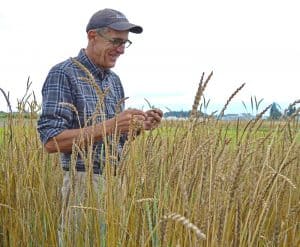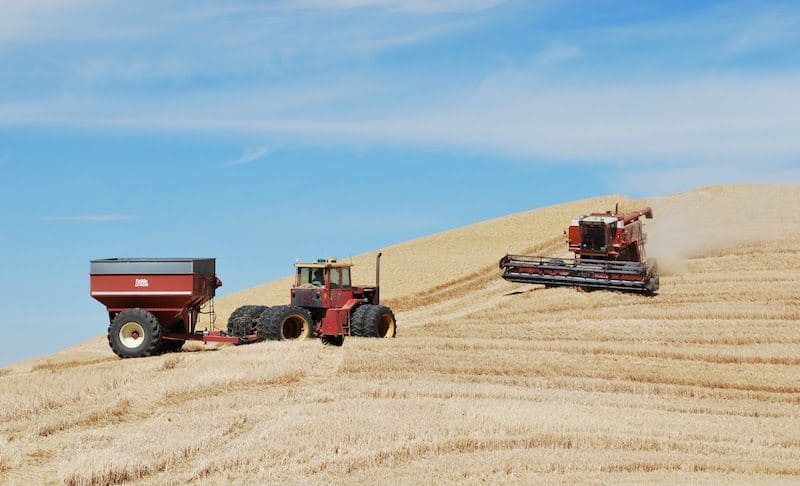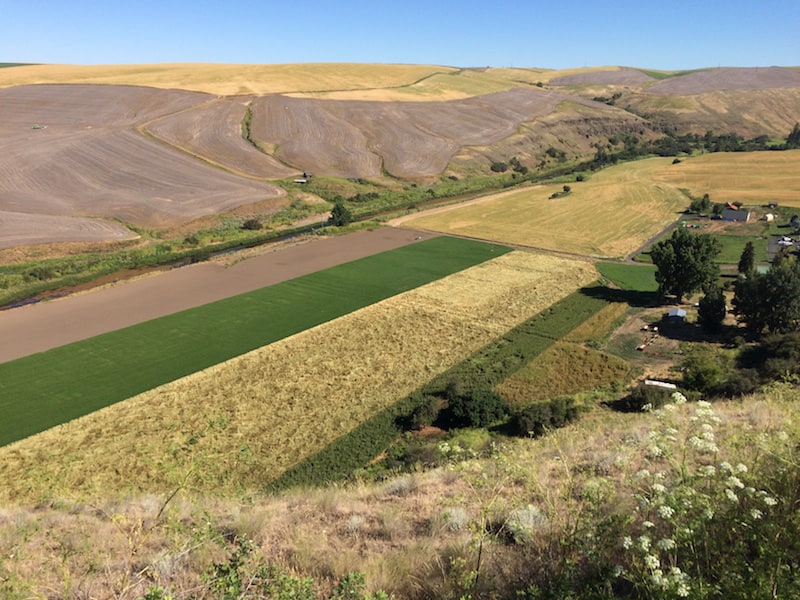Washington’s Grain: Bread, Beer & Spirits Get a Local Makeover
written by Catie Joyce-Bulay

Washington grows around 1.5 million bushels of wheat each year. Most of the state’s fifth-largest crop is shipped overseas and never seen by local consumers. This industrial-style farming is a market-driven endeavor, but many farmers around the region are working on changing the system—changing the way we think about our food, and changing the flavors of our local beer, spirits and pastries.
Bill Myers, a fifth-generation Palouse wheat farmer, was struggling to get by when the markets crashed in 2008. He knew he needed another option, and with a little online research discovered he might be able to sell his grains directly to home bakers, bypassing the commodities market.
“I felt kind of silly. Here we are, big-production agriculture on 3,300 acres, and out there selling wheat in little baggies to people,” he said of his early farmers market days. “But there seemed to be an interest, so I thought, ‘OK, let’s put up a website, maybe the numbers will amount to something.’” Since then, numbers have doubled every year.
Joseph’s Grainery, named after Myers’ father, now sells flour and pancake mixes in regional grocers, but it didn’t really start
to pick up until the director of LINC Foods, Joseph’s Grainery’s distributor, decided to get into malting. It turned out the barley variety Myers had been growing as livestock feed all this time made an excellent malt. A handful of Spokane brewers really dug the nutty flavor and surprisingly sweet finish of the Baronesse barley malt. Then a few regional distillers discovered it.
Now stories like Myers’ are playing out in local communities across the Northwest.

BAKING BETTER BREAD
For bakers, local whole grain flour is a big departure from what they’re used to. Most of the nation’s flour comes from wheat hybridized for high yields over flavor and nutrition—it’s then sent to only about four flour milling companies for processing.
“When you get a bag of flour from the grocery store it comes from hundreds of farmers,” said Kathleen Small, of Small’s Family Farm in Walla Walla. “What you get is just an aggregate quality of everybody’s combined.”
An avid baker, it wasn’t until she enrolled in culinary school and her instructor introduced her to the idea that she began to think about turning the family’s wheat into flour for local use. The fourth- generation farm now turns about 25 percent of its wheat, which performed at the highest level in quality testing done by the Western Wheat Quality Lab at Washington State University, into flour for local and regional distribution.
“I’ve farmed with my husband for thirty-four years now,” Small said. “I think about every summer I spent at the elevator dumping loads of wheat or driving the tractor. Then I turn around and I walk into my kitchen or a local restaurant and I eat something made with our flour—it’s very exciting.” Her son, Seth, who now farms with them and was instrumental in bringing their wheat back to the local level, agrees. “There used to be thousands and thousands of mills,” he said. “They were really related to farmers and farming, so we’re really excited to be a part of bringing that back.”
Before the early 1900s, most towns had their own mill and early Americans and Europeans used a different flour for everything they baked, according to historian Dick Scheuerman, who co-owns Palouse Heritage with brother Don. There they raise landrace, or non-hybridized, grain in Colfax. “A hundred years ago there really was a crepe grain, and there was a biscuit grain, and a pancake grain and a waffle grain,” he said.
Scheuerman fell in love with landrace grains because of their stories and the detective work required to track down the seeds, but quickly realized each had unique flavor profiles he likens to those of fine wines.
Artisan bakers like Rob Salvino, of Seattle’s Damsel & Hopper Bakeshop, and Angela Kora, of Richland’s Ethos Bakery & Café, appreciate the efforts. “It was really great to learn about what was going on in our own backyard,” said Kora, who opened Ethos in 2011 when it was difficult to find a local grain supplier. She was surprised and excited by how much the industry had changed in a few short years when she met Scheuerman in 2016.
Ethos now uses a mix of traditional and Palouse Heritage’s Sonoran Gold flour, thought to be the first cereal grain introduced to North America, in its pie dough, shortbread cookies and donuts. Ethos is also developing bread and pizza crust recipes with its Crimson Turkey wheat, a hard red winter wheat ancestor to modern bread wheat.
Salvino describes the Sonoran Gold wheat he bakes into bread, crackers, cookies and croissants as mild, buttery, cakey and well-behaved. “Flavorwise, it’s pretty amazing how much [these flours] add to anything you’re baking with. Even if it’s a minor percentage, it still can add a lot of flavor,” said Salvino, who adds it was a process to develop recipes and figure out how each flour would perform.


BEHIND GOOD GRAINS
The epicenter of Washington’s craft grain movement resides at Washington State University’s Bread Lab in Skagit Valley. The program was started in 2011 by director Dr. Steven Jones, who was tasked with helping Western Washington farmers—who only grew wheat in rotation for soil health—to develop varieties with a market value. He soon brought Steve Lyon, senior scientific assistant, on board, and they discovered farmers were growing the wrong variety for the region.
“The first thing that we were told was you can’t get a good bread wheat in a high rainfall area,” said Lyon, who leads the greenhouse and field research. “We found out that you can, and that there’s a real terroir to the soils.” Fast forward seven years and the Port of Skagit Valley, which houses the new 12,000-square- foot Bread Lab opened in 2017, is a buzzing local food hub.
It takes around twelve years to develop a grain cultivar, starting from seeds in the greenhouse and progressing to larger and larger trial plots, testing for disease resistance and yields. Then flavor and nutrition are examined in the Bread Lab’s test kitchen. The grains coming out of the Skagit Valley are rich in minerals, three times the national average, which Lyon said adds to the flavor and the ability to define a regional terroir.
The Bread Lab’s baker, Julia Berstein, who has a degree in biology and studied traditional breadmaking in Morocco, mills each new grain variety into flour and bakes it into a sourdough. With that she compares the mixing, shaping and cooking process and, of course, the taste, which Lyon, a frequent taste tester, adds is a great job perk. Grains that don’t perform well won’t make the cut to continue on to commercial farmers. To date, the Lab has released twenty-one types of wheat and two of barley.
One popular variety the lab developed, and a favorite of Berstein, is Skagit 1109. “The bran has a nice sweet nuttiness,” Berstein said. “It’s not too grassy or bitter, and it’s not too bland like a lot of flours can be.” Another recent favorite, still in development, is cosmos, with a surprisingly lemony scent.

IS MALT THE NEW HOPS?
Ask many brewers and distillers and they will tell you, it isn’t just bakers who are excited to experiment with these craft grains.
“I’ve been telling everybody that will listen that malt is the new hop,” said co-owner of Copperworks Distilling Company Jason Parker at this year’s sixth annual Cascadia Grains Conference, presented by WSU and Oregon State University. He and other distillers are working with the Bread Lab to develop flavor profiles in their spirits that will lead to a distinct regional terroir, much like the beer industry developed with hops fifty years ago and wine grapes before that. Parker eventually wants consumers to think about American single-malt whiskeys the same way they think about wine vintages, comparing one year’s grain harvest to the next in each bottle.
Across the state in Spokane, LINC Malt (formerly Palouse Pints) is malting the grains from Myers, Scheuerman and MJW Grain’s farms. Joel Williamson started LINC Malt in 2016 as an accompaniment to LINC Foods, the local foods distribution co-op he runs with Beth Robinette.
When Williamson first began looking into malt he saw it had a very similar story to flour. “I’d been homebrewing for a long time and in starting LINC Foods it really got me thinking, ‘Where does malt come from?’” he said. “It was an interesting learning experience to find that malting was highly consolidated. There’s just a couple really large companies that do it. You can’t really ever tell where the grain is coming from necessarily.”
Local brewers were excited to get onboard. Thomas Croskrey brews much of Bellwether Brewing’s beers with LINC’s malt and said the flavor is at an 11 or 12 on a scale of 10.
In addition to the flavor and denser nutrient tables of local grains, he appreciates working with the farmers and maltster, a resounding sentiment shared by all in this pioneering industry—not only do they have a great sense of pride in their own work, but they thoroughly enjoy supporting and working with each other.







